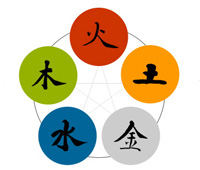 |
|
Five Element theory
is one of the major systems of thought within traditional Chinese
medicine. Also referred to as the “five phase” theory by some
practitioners, Five Element theory has been used for more than 2,000 years
as a method of diagnosis and treatment. While it is an important component
of traditional Chinese medicine, today Five Element theory is not used by
every practitioner of Oriental medicine; rather, it is employed to a
certain degree, depending on the practitioner’s training and education.
The five elements, or five-phase
theory, is also grounded in the notion of harmony and balance. The concept
of chi, which means "life force" or "energy," is
perhaps most different from Western ideas. Traditional Chinese Medicine asserts that chi is
an invisible energy force that flows freely in a healthy person, but is
weakened or blocked when a person is ill. Specifically, the illness is a
result of the blockage, rather than the blockage being the result of the
illness.
back to top
|
|
Five
Element Healing
The
Five Element Theory,
also called the five-phase theory, holds that everything in the universe,
including our health, is governed by five natural elements:
Wood,
Fire,
Earth,
Metal
and
Water.
This theory underscores the Chinese Medicine
understanding that human beings, both physically and mentally, are
intertwined with nature. Although it is difficult for Westerners to relate
this philosophy to the Western approach to medicine, it is fundamental to
the understanding of Traditional Chinese Medicine.
In
the five element theory, each of the five elements has a season,
particular organs, emotions and senses associated with it, such as taste,
smell, color,
sound. The wood element, for example, is associated with spring, the
liver, and the gall bladder. Similarly, the fire element is
associated with early summer, the heart, and small intestines; the earth
element corresponds to late summer, the stomach and spleen; metal is
associated with autumn, the lungs and large intestine; and water is
associated with winter, the kidneys and bladder.
Wood, Fire, Earth, Metal, and Water are interrelated aspects of energy
that are evident throughout nature, including in the human body. An individual's state of health manifests
according to the balance between these Elements.
In contrast to Western
medicine's teaching of a separation between the mind and body, TCM views
each organ as having particular body and mind functions, as illustrated in
the belief that the liver is involved in planning, and in the storage of
anger, while the gall bladder is the organ of decision-making.
At the
heart of five element practice lies an understanding that the many
physical ailments our society suffers from are often as much the product
of emotional distress as of any physical cause. In many cases, they can
only fully be alleviated when these inner stresses are addressed.
Five
Element theory is used to help explain the cause(s) of particular
diseases, and to associate signs or symptoms to particular organs and
afflictions. In the context of “phases,” Five Element theory helps to
explain the processes that are occurring the body throughout various
stages of disease and healing. This is particularly useful in explaining
the processes that take place during the generating and controlling cycles
mentioned in Five Element theory.
It is
the role and responsibility of a five element practitioner to learn to
detect where imbalances lie, and more importantly, from where they
arise. We learn to develop the sensory skills of seeing, hearing,
smelling, touching and feeling - skills we are born with but rarely use in
the modern world.
Five Element Healing principles help the practitioner to gain an
understanding of the constitutional strengths and weaknesses of each
individual. This understanding in turn helps the patient to gain a greater
understanding of themselves.
For detailed information
about Five Element Healing
visit
www.energmedc.com
Learn more about
Five
Element Constitutional Assessment
|
|

